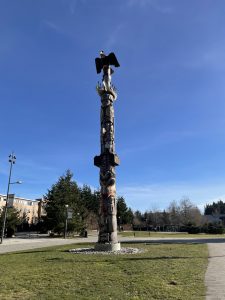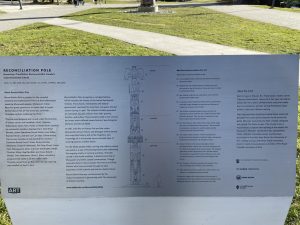The Reconciliation Pole at UBC is located on the Main Mall, outside of the Forestry Building. It was carved by Canadian and Haida artist Jim Hart, and it was installed on April 1, 2017. Recognizing the complex history between the Indigenous people and the Canadian government, the Pole records a lot of memories and moments, including the painful history of the Canadian Indian Residential Schools. The purpose of the Reconciliation Pole is to make sure the student and the public will not the dark history of the country and will work together to avoid anything similar from happening again.

Picture of the Reconciliation Pole taken by myself, February 2022
The Reconciliation Pole records the history of the Canadian Indigenous population from the bottom to the top chronically. The bottom part shows the time before the residential schools policy, where the life of the Indigenous people being uninterrupted, a lot of it demonstrated the relationship between the tribes and the nature and the respect that the Indigenous people holds towards the gods. The middle part was the part about the time during residential schools were operating. It showcased the children were caught between their original culture that the government at the time wanted to be wiped and the “correct” culture taught in. the residential schools. The top part was about the post-residential school era, which we can see Indigenous students can embrace their own culture freely, and diversity was being respected.
The history of Canadian Indian Residential Schools goes back to the 1880s, they were run by churches across the country for over a century and served the purpose of “killing the Indian child”. It was a government-instituted system designed to assimilate and destroy all indigenous culture over Canada. During the time the school operated, over 150,000 Indigenous children were unwillingly taken from their families. Most students faced abused physically, psychologically and sexually, many students could not stand the torture and died in the schools.

Picture of the sign showing the information of the Reconciliation Pole, February 2022
The way I see the message that lies behind the Pole is more than only providing the Indigenous population a sense of belonging in UBC and Canada, but also for newcomers to Canada and other people around the globe. One of the biggest function of The Reconciliation Pole is that it symbolize how the Canada as a country and its people embraces diversity, respect differences between people. As a non-Canadian student at UBC, I can definitely feel the spirit promoted by the Pole at UBC. Unlike many countries in the world that tend to hide the dark side of their history, I very much appreciate the courage that Canada has to amid what was done to the Indigenous population was wrong and is now doing its best to make up for the wrongdoings. This shows the country is actually committed in erasing barriers between people with different ethnicities. Only by facing the history can we become better together.
Given that the UBC Vancouver Campus is located on the traditional, ancestral and unceded land of the Musqueam people, there is no better place for the Reconciliation Pole to be located. Putting the symbolic monument of promoting Indigenous right at one of the finest institute showcases the emphasis on respecting Indigenous culture. The Pole serves the educational purpose of telling young people the mistakes people before them had made. Also, choosing a totem pole as a representation of the history is a great choice for me. A totem pole in the indigenous culture represents and commemorate ancestry, histories, people, or events. Recording the Indigenous history with a totem pole instead of other forms of arts shows how their culture is actually being valued.
I would like to also defend the placement of the Reconciliation Pole. Some may think the placement of the Pole is too far away from the center of the campus that many students may not walk by unless paying an intentional visit. However, I believe the choice of the location for the pole is actually showing respect to the Indigenous culture. A lot of Indigenous culture emphasize the relationship between human and the nature, the nature is what many of the Indigenous people fear and would protect. Placing the Reconciliation Pole next to the Forest Science Center, which is dedicating to preserve the nature, would be a modernized way of continuing the mission of many Indigenous people.
In conclusion, the Reconciliation Pole is a perfect symbol of providing Indigenous students a warm welcome while constantly reminding people nowadays the painful past of the country.
Please feel free check the links down below if you are interested in knowing more about the Reconciliation Pole and the Indigenous Culture.
Hey Gordon! I enjoyed reading your blog and learning more about the Reconciliation pole on campus. I totally agree with you that most countries tend to hide their dark history instead of honoring it. Before coming to Canada I lived in Chile and Brazil, while both countries have had a very dark and sad history, it really wasn’t talked about and when it was it would be in a “historical” way instead of showing the current impacts it has on the people. Coming to Canada and seeing many forms of Indigenous arts right when landing at the airport was a very big cultural impact to me.